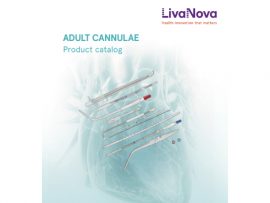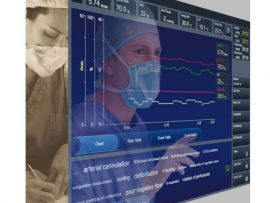Abstract Cardiopulmonary bypass (CPB) impacts pharmacokinetics and -dynamics of drugs used during cardiac surgery. These alterations can lead to changes in drug efficacy resulting in under- or overdosing. This review..
WeiterlesenAbstract Objective: To create and verify a model that predicts the risk of stress hyperglycemia (SHG) in patients without diabetes after cardiac surgery. Design: Retrospective analysis. Methods: This retrospective analysis analyzed patients without..
WeiterlesenAbstract Objective This study aimed to evaluate the validity of models using Procalcitonin (PCT) alone and PCT combined with other biomarkers to predict early infection after pediatric open-heart surgery with..
WeiterlesenAbstract Background Cardiac surgery on cardiopulmonary bypass (CPB) may alter platelet (PLT) function causing bleeding. The goal of this study is to evaluate the hemostatic effect of PRT-PLTs compared to..
WeiterlesenAbstract Background: This study aimed to investigate the impact of early extubation on stress response and neurodevelopmental outcomes after pediatric cardiac surgery utilizing cardiopulmonary bypass (CPB). Methods: In this single-center prospective pilot..
WeiterlesenAbstract OBJECTIVES Peripheral cannula selection in minimally invasive cardiac surgery (MICS) is crucial, as venous drainage limitations during cardiopulmonary bypass (CPB can impair end-organ perfusion and overall outcomes. This study..
WeiterlesenAbstract Background Acute gastrointestinal injury (AGI) after cardiopulmonary bypass (CPB) is associated with poor prognosis. This study aimed to evaluate the effect of preoperative probiotic supplementation on the incidence of..
WeiterlesenAbstract Background Current indicators for monitoring intraoperative organ function remain predominantly indirect, delayed and non-specific, particularly in paediatric populations undergoing congenital heart surgery, where multifactorial influences further complicate functional assessments. Emerging..
WeiterlesenAbstract Purpose Cardiopulmonary bypass (CPB) during cardiac surgery mechanically circulates and oxygenates the blood, bypassing the heart and lungs. Despite limited evidence, maintaining mechanical ventilation (MV) during CPB is recommended,..
WeiterlesenIntroduction Left ventricular (LV) thrombus formation is a known complication associated with acute myocardial infarction and other conditions that impair LV function, carrying a risk for systemic embolization., In this report,..
WeiterlesenAbstract Background: In cardiac surgery, protamine is used to reverse the effects of heparin after separation from cardiopulmonary bypass (CPB). Excess of protamine has been demonstrated to cause platelet dysfunction and..
WeiterlesenAbstract Introduction: Cardiopulmonary bypass (CPB) is utilized during cardiovascular surgery to maintain organ oxygen supply and blood perfusion instead of cardiopulmonary function. Three primary methods of artery cannulation used for CPB..
WeiterlesenAbstract Patients undergoing cardiopulmonary bypass (CPB) often experience neurological complications, but the neurobiological mechanisms remain unclear. This study combined resting-state fMRI, structural MRI, and cognitive testing to examine brain changes..
WeiterlesenAbstract Objective Acute kidney injury (AKI) affects approximately 30% of patients undergoing cardiac surgery with conventional non-pulsatile cardiopulmonary bypass (CPB). Pulsatile flow has long been proposed for mitigating this complication...
WeiterlesenAbstract OBJECTIVES Acute kidney injury (AKI) is a common consequence of surgical repair of the thoraco-abdominal aorta (TAA). Perfusion techniques aim to facilitate renal protection through oxygenation or hypothermia. This..
WeiterlesenAbstract Background Gastrointestinal complications (GICs) following cardiac surgery with cardiopulmonary bypass (CPB) significantly impact postoperative recovery and clinical outcomes. Methods This single-center, retrospective cohort study evaluated the incidence, risk factors,..
WeiterlesenAbstract Background: The objective of this study was to describe thrombin generation in children undergoing cardiac surgery with cardiopulmonary bypass (CPB). Change in the endogenous thrombin potential (ETP) across three..
WeiterlesenAbstract Assessment of cerebral autoregulation is challenging under different hemodynamic conditions during cardiac surgery and must be rapidly calculated in order to optimize mean arterial pressure (MAP). Whether systemic flow..
WeiterlesenAbstract Purpose Cardiac surgery associated acute kidney injury (CSA-AKI) is a frequent and severe complication. Goal Directed Perfusion (GDP) during cardiopulmonary bypass (CPB) has been developed to reduce post-operative complications,..
WeiterlesenAbstract Licensure in medicine originated in London when a small group of physicians led by the scholar Thomas Linacre petitioned King Henry VIII to establish a college of physicians on..
WeiterlesenAbstract Objective To describe the occurrence of cerebral desaturation (≥10% decrease or <50% in regional cerebral oxygen saturation [rSO₂]), deep anesthetic states (processed electroencephalography patient state index [PSI] <25), and..
WeiterlesenAbstract Background: Postoperative Acute kidney injury (AKI) is a significant concern for cardiac surgery patients with chronic kidney disease (CKD). Effective pharmacological interventions to mitigate these risks are urgently needed...
WeiterlesenAbstract Background Understanding cerebral blood flow regulation and later optimizing brain perfusion is part of neuroprotection during cardiopulmonary bypass (CPB) in neonates. Methods A total of 38 neonates undergoing CPB..
WeiterlesenAbstract Perioperative pulmonary arterial hypertension (PAH) is a common complication of chest surgery with cardiopulmonary bypass (CPB) and its etiology is multifactorial. Patients undergoing this surgery often have underlying conditions,..
WeiterlesenAbstract Acute kidney injury (AKI) is a complex clinical syndrome with a spectrum of clinical manifestations and outcomes (1); characterized by the deterioration of renal function over a period of..
WeiterlesenAbstract OBJECTIVES The question whether minimally invasive extracorporeal circulation (MiECC) represents the optimal perfusion strategy in cardiac surgery remains unanswered. We sought to systematically review the entire literature and thoroughly..
WeiterlesenAbstract Background: This study aimed to investigate the effect of operative and postoperative parameters on late-onset hyperlactatemia (LOHL) after cardiac surgery in the pediatric patient population.Methods: One hundred fifty-nine ventricular septal defect..
WeiterlesenAbstract Brain injury and cerebral inflammation are frequent complications following cardiopulmonary bypass (CPB) resulting in neurocognitive dysfunction, encephalopathy, or stroke. We compared cerebral inflammation induced by del Nido and histidine-tryptophan-α-ketoglutarate..
WeiterlesenAbstract The branch-first technique (BFT) for aortic arch replacement eliminates deep hypothermia and global circulatory arrest, reducing cardiopulmonary bypass and ischemic times. We present our initial experience with BFT in..
WeiterlesenAbstract Introduction Sternotomy has been the most common approach for the correction of congenital cardiac defects, and questions arise surrounding the safety, feasibility, and cost-effectiveness of implementing minimally invasive techniques..
Weiterlesen

















